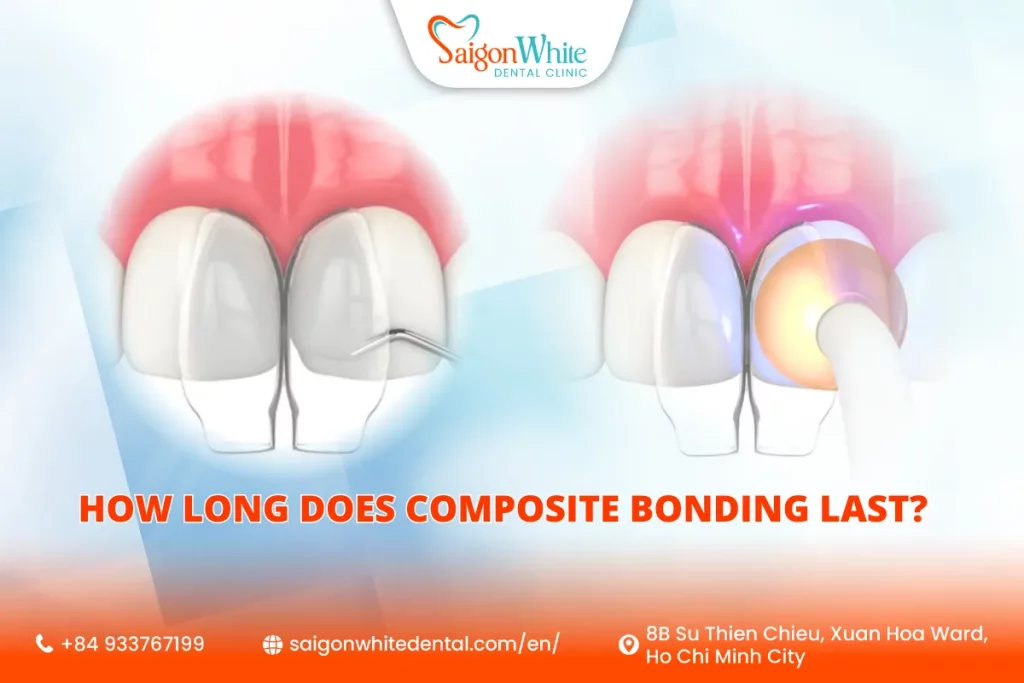How long does composite bonding last? — It’s one of the most common questions patients ask when considering smile enhancement treatments in Vietnam. Known for its quick results, natural look, and affordability, composite bonding in Vietnam has become a preferred choice among both locals and international patients.
With advanced clinics, skilled English-speaking dentists, and international-quality care, composite bonding in Ho Chi Minh City is now recognized as one of the best options for achieving a confident smile in Asia.
In this guide, Vietnamese dentists share expert insights on how to extend the lifespan of your composite bonding and keep your smile looking radiant for years.

1. What Is Composite Bonding and How Does It Work?
Composite bonding is a cosmetic dental technique used to correct minor imperfections such as chipped, stained, or uneven teeth. The dentist applies a tooth-colored resin composite material directly onto the tooth surface, shapes it carefully, and hardens it using a curing light. The result is a natural-looking, smooth, and bright smile.
Unlike veneers or crowns that require reshaping or removal of enamel, composite bonding is minimally invasive. The procedure usually takes about 30–60 minutes per tooth, with no anesthesia required unless combined with other treatments.
Benefits include:
- Affordable and fast compared to porcelain veneers.
- Immediate improvement in smile aesthetics.
- Reversible procedure – no permanent alteration to the natural tooth.
- Easily repairable if chipped or worn.
This balance between cost, comfort, and cosmetic enhancement makes composite bonding one of the most popular treatments in Vietnam’s dental clinics.
2. Average Lifespan of Composite Bonding
So, how long does composite bonding last? On average, it can last 5 to 10 years, depending on your lifestyle, oral hygiene, and how well you maintain it.
According to Vietnamese dentists at Saigon White Dental in Ho Chi Minh City, the material quality and skill of the dentist play crucial roles in longevity. A well-performed bonding treatment can even last beyond 10 years with proper care.
When compared with other aesthetic solutions:
- Composite bonding: 5–10 years
- Porcelain veneers: 10–20 years
- Crowns: 15–25 years
While bonding may not last as long as porcelain, it’s far more affordable and easier to repair. For many patients, especially those traveling to Vietnam for dental tourism, this makes it an excellent entry-level cosmetic treatment.
3. Key Factors That Affect How Long Composite Bonding Lasts
3.1. Oral Hygiene Habits
The simplest yet most powerful factor is how well you care for your teeth.
- Brush your teeth twice daily using a soft-bristled toothbrush and a non-abrasive toothpaste.
- Floss every day to remove plaque and prevent gum inflammation.
- Rinse with alcohol-free mouthwash to protect both natural teeth and bonding material.
Consistent hygiene helps prevent discoloration, decay near bonded areas, and overall wear.
3.2. Diet and Lifestyle
Your eating and drinking habits can greatly influence the color and strength of composite resin. Vietnamese dentists recommend limiting foods and beverages that stain teeth, such as:
– Coffee, tea, red wine, and dark sauces.
– Tobacco and vaping products.
Additionally, avoid biting hard foods (like ice, nuts, or candies) that could chip or crack the bonding surface.
Patients who maintain a tooth-friendly diet often enjoy longer-lasting, brighter smiles.
3.3. Dental Check-Ups and Maintenance
Routine dental visits — every 6 months — are essential for inspecting the condition of your composite bonding.
Dentists can polish away minor stains, smooth out rough edges, and check for early wear.
In clinics like Saigon White Dental, touch-up polishing or small repairs are inexpensive and quick, often done within 15–20 minutes. This proactive care helps extend the lifespan of your bonding and maintains its natural shine.
3.4. Skill and Materials Used
One often overlooked factor is the dentist’s artistry. Composite bonding is not just about filling or shaping — it’s about sculpting a smile. The layering technique, resin quality, and finishing polish all determine how realistic and durable the result will be.
Top Vietnamese dentists use imported materials (e.g., 3M, Ivoclar Vivadent, or GC) that are known for high strength and color stability. Combined with precise technique, these materials can withstand years of wear even in humid climates like Vietnam.
4. Expert Maintenance Tips from Vietnamese Dentists
Dentists in Ho Chi Minh City, such as those at Saigon White Dental, share valuable advice to help your composite bonding last as long as possible.
Brush Gently but Thoroughly
Use a soft toothbrush and fluoride toothpaste. Avoid whitening toothpaste that contains harsh abrasives — they can dull the resin’s shine.
Avoid Excessive Pressure
Don’t use your teeth as tools to open packages or bite on pens. Pressure cracks can form and shorten bonding life.
Schedule Regular Cleaning
Professional cleaning and polishing every 6 months keeps your bonding stain-free and smooth.
Address Grinding or Clenching
If you suffer from bruxism (teeth grinding), ask your dentist for a night guard. Grinding is one of the leading causes of premature damage.
Limit Acidic and Staining Drinks
Use a straw when drinking coffee, soda, or fruit juice to minimize contact with the bonding surface.
Get Quick Repairs When Needed
If your bonding chips, cracks, or changes color, visit your dentist promptly. Small fixes can be done easily without replacing the entire restoration.
6. Common Signs It’s Time to Replace or Repair Your Bonding
Even with great care, composite bonding will eventually need attention. Look out for these signs:
- Discoloration that doesn’t polish away – Resin can pick up deep stains over time.
- Chips or cracks – Often caused by biting hard foods or grinding.
- Rough or uneven texture – Indicates wear from brushing or chewing.
- Gaps forming between teeth – Bonding may shrink slightly with age.
- Sensitivity – Could mean that bonding edges have lifted, exposing dentin.
If you notice any of these issues, schedule a dental visit. Early repair prevents further damage and maintains your smile’s appearance.
7. How Much Does Composite Bonding Replacement Cost in Vietnam?
Vietnam is widely recognized for offering affordable dental care without compromising quality.
Here’s a general estimate for composite bonding costs (per tooth):
- Vietnam: USD $60–$120
- Australia / USA: USD $250–$600
This price difference explains why thousands of travelers choose Vietnam for their cosmetic treatments every year.
At clinics like Saigon White Dental, patients can enjoy high-quality resin materials, digital color matching, and precise contouring — all at a fraction of Western costs. Many international patients report saving up to 70% compared to home-country prices while still achieving beautiful, natural results.
8. Why Choose Vietnam for Composite Bonding and Maintenance
Vietnam’s dental industry has undergone tremendous transformation in the past decade. Ho Chi Minh City now houses international-standard clinics that rival those in Singapore or Bangkok, yet at significantly lower prices.
8.1. Advanced Technology
Clinics are equipped with digital scanners, LED curing lights, and modern composite systems that ensure strong adhesion and a natural finish.
8.2. Experienced, English-Speaking Dentists
Many Vietnamese dentists have trained in Australia, Japan, or the United States. Their bilingual communication ensures comfort and confidence for international patients.
8.3. Affordable Cosmetic Care
Vietnam offers excellent value for money — combining expert skill with cost savings. This makes it ideal for long-term maintenance like bonding touch-ups or polishing visits.
8.4. Dental Tourism Experience
Beyond dental care, Vietnam’s hospitality, cuisine, and culture make it an appealing destination for combining treatment with travel. Patients often plan their smile makeover as part of a vacation itinerary.
9. Longevity Comparison: Composite Bonding vs Veneers
| Aspect | Composite Bonding | Porcelain Veneers |
|---|---|---|
| Durability | 5–10 years | 10–20 years |
| Material | Resin composite | Porcelain ceramic |
| Aesthetic Finish | Good, slightly less glossy | Highly natural, reflective |
| Repairability | Easy to fix | Difficult to repair |
| Cost (per tooth) | $60–$120 (Vietnam) | $250–$600 (Vietnam) |
| Time Required | 1 visit | 2–3 visits |
| Invasiveness | Non-invasive | Requires enamel removal |
This table shows why composite bonding remains a preferred choice for patients seeking affordable, fast, and reversible smile enhancement, especially in Vietnam.
10. Testimonials from Vietnamese Dentists
“Composite bonding is perfect for patients who want to correct small imperfections without major procedures. With proper maintenance, it can look beautiful for 8 to 10 years,”
— Dr. Tân, Cosmetic Dentist at Saigon White Dental.
“Most of our patients, both local and international, come back only for polishing or minor repairs every few years. The bonding material we use is designed for tropical climates, ensuring long-term durability.”
— Dr. Ngân, Restorative Dentistry Specialist.
11. Maintenance Schedule: Keep Your Smile Fresh
| Time Frame | What to Do |
|---|---|
| Daily | Brush twice with fluoride toothpaste, floss, and avoid staining drinks. |
| Every 6 Months | Dental cleaning and polishing to remove minor stains. |
| Every 2–3 Years | Touch-up bonding for shape or color refresh. |
| Every 7–10 Years | Consider full replacement if needed. |
Following this schedule helps your composite bonding maintain its shine and shape for up to a decade.
12. Aftercare: Immediate Post-Treatment Tips
Right after your bonding appointment, follow these steps for the best results:
- Avoid colored drinks and smoking for 48 hours.
- Refrain from hard or sticky foods.
- Don’t bite nails or open bottles with your teeth.
- Schedule your follow-up check after one week.
These small actions ensure the bonding fully sets and maintains its luster.
13. Environmental Advantage: Eco-friendly Dentistry in Vietnam
Many Vietnamese clinics, including Saigon White Dental, now adopt eco-friendly dental practices such as resin recycling and minimal-waste systems.
These initiatives not only protect the environment but also ensure that your treatment follows sustainable healthcare principles — a growing priority for global travelers seeking responsible dental tourism.
14. Choosing the Right Clinic in Vietnam
When selecting where to get composite bonding, consider:
- A dentist’s experience in cosmetic dentistry.
- Use of imported resin materials.
- Clinic hygiene standards and sterilization protocols.
- Transparent pricing and before-and-after photo samples.
Clinics like Saigon White Dental are known for their precision, artistry, and personalized care, making them a reliable choice for both first-time patients and returning travelers.

 Telegram
Telegram